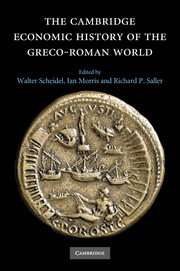Book contents
- Frontmatter
- 1 Introduction
- Part I Determinants of Economic Performance
- Part II Early Mediterranean Economies and the Near East
- Part III Classical Greece
- Part IV The Hellenistic States
- Part V Early Italy and the Roman Republic
- Part VI The Early Roman Empire
- 20 The Early Roman Empire: Production
- 21 The Early Roman Empire: Distribution
- 22 The Early Roman Empire: Consumption
- 23 The Early Roman Empire: The State and the Economy
- Part VII Regional Development in the Roman Empire
- Part VIII Epilogue
- Bibliography
- Index
- Map 1.1 The Mediterranean basin"
- Map 10.1 Greek and Phoenician trade in the period of the Persian Wars"
- Map 11.1 The Achaemenid empire"
- Map 12.1 Greece and Asia Minor"
- Map 15.1 The Seleucid empire"
- Map 16.1 Greco-Roman Egypt"
- Map 20.1 The Roman empire at the accession of Vespasian"
- References
23 - The Early Roman Empire: The State and the Economy
from Part VI - The Early Roman Empire
Published online by Cambridge University Press: 28 March 2008
- Frontmatter
- 1 Introduction
- Part I Determinants of Economic Performance
- Part II Early Mediterranean Economies and the Near East
- Part III Classical Greece
- Part IV The Hellenistic States
- Part V Early Italy and the Roman Republic
- Part VI The Early Roman Empire
- 20 The Early Roman Empire: Production
- 21 The Early Roman Empire: Distribution
- 22 The Early Roman Empire: Consumption
- 23 The Early Roman Empire: The State and the Economy
- Part VII Regional Development in the Roman Empire
- Part VIII Epilogue
- Bibliography
- Index
- Map 1.1 The Mediterranean basin"
- Map 10.1 Greek and Phoenician trade in the period of the Persian Wars"
- Map 11.1 The Achaemenid empire"
- Map 12.1 Greece and Asia Minor"
- Map 15.1 The Seleucid empire"
- Map 16.1 Greco-Roman Egypt"
- Map 20.1 The Roman empire at the accession of Vespasian"
- References
Summary
introduction
Many scholars envision a modest increase of the GDP of the Roman empire during the first two centuries of the Principate or, for certain regions, even since the second century bc, and some of the contributors to this volume share this view. Some also believe that the increase in GDP in the regions outside Italy, particularly but not only in the western ones, during the first two centuries of the Principate, was primarily the outcome of an increase in population, even if a quantitative estimate of any such increase is obviously beyond our reach for most parts of the empire. For those regions where slim literary and documentary evidence exists, such as Egypt, the size of the population remains a controversial issue. However, the evidence of land surveys in several parts of the empire seems to point to the spread of cultivation and settlement to new areas and the extension of cultivation in previously inhabited areas, while the diffusion of new urban centers and the enlargement of existing ones also suggest demographic growth. The Antonine Plague must have caused a marked decrease in population and consequently a decrease in GDP.
There is less consensus on whether this surmised growth of GDP in the whole of the empire between the Augustan and the Antonine periods was matched by growth in per capita income. Per capita growth can be postulated, by looking at comparative evidence, for the period after the Antonine Plague as an effect of the slackening of population pressure in some areas of the empire and the resulting gain in contractual power by the peasants.
- Type
- Chapter
- Information
- The Cambridge Economic History of the Greco-Roman World , pp. 619 - 648Publisher: Cambridge University PressPrint publication year: 2007
References
- 33
- Cited by

